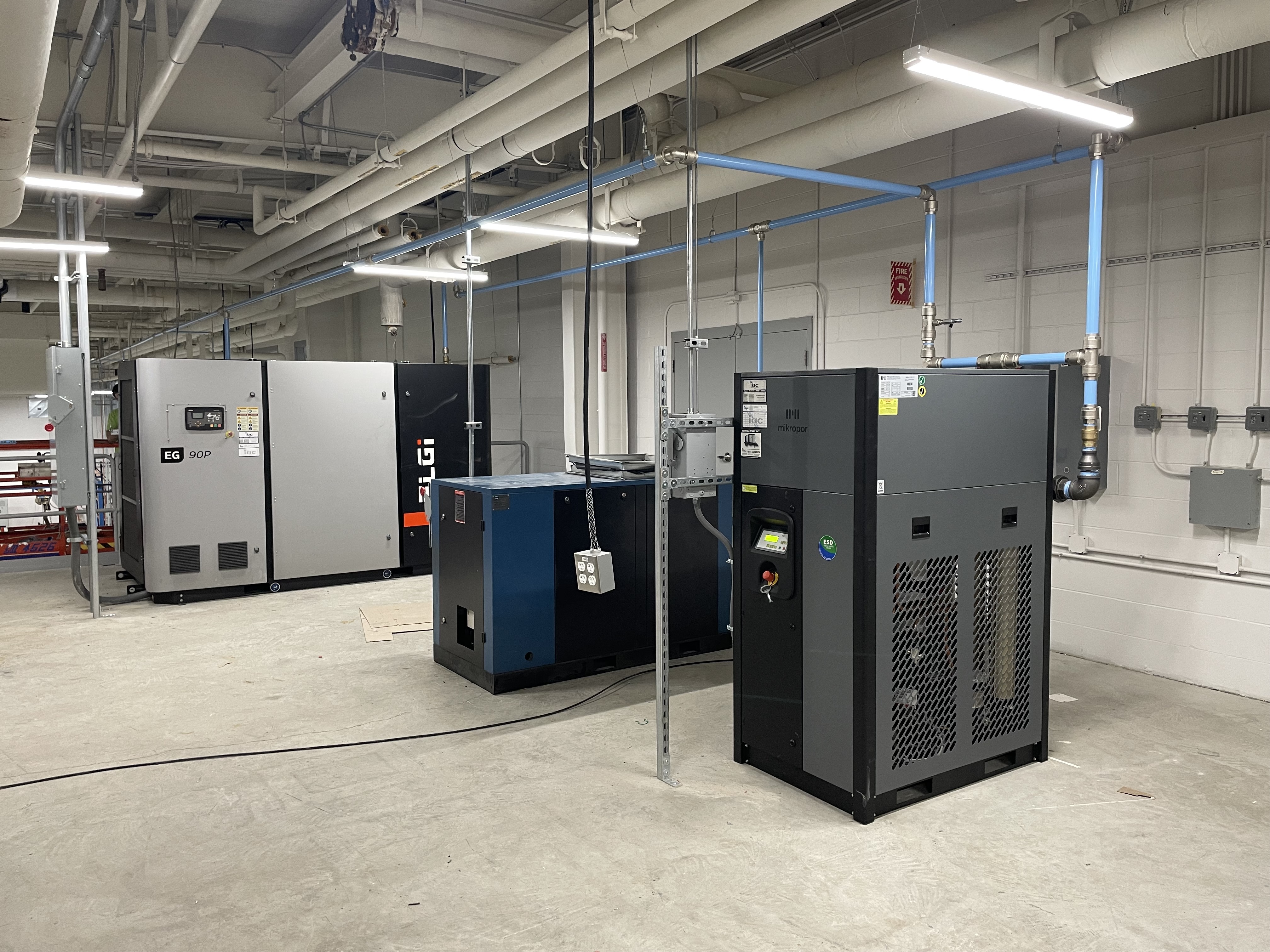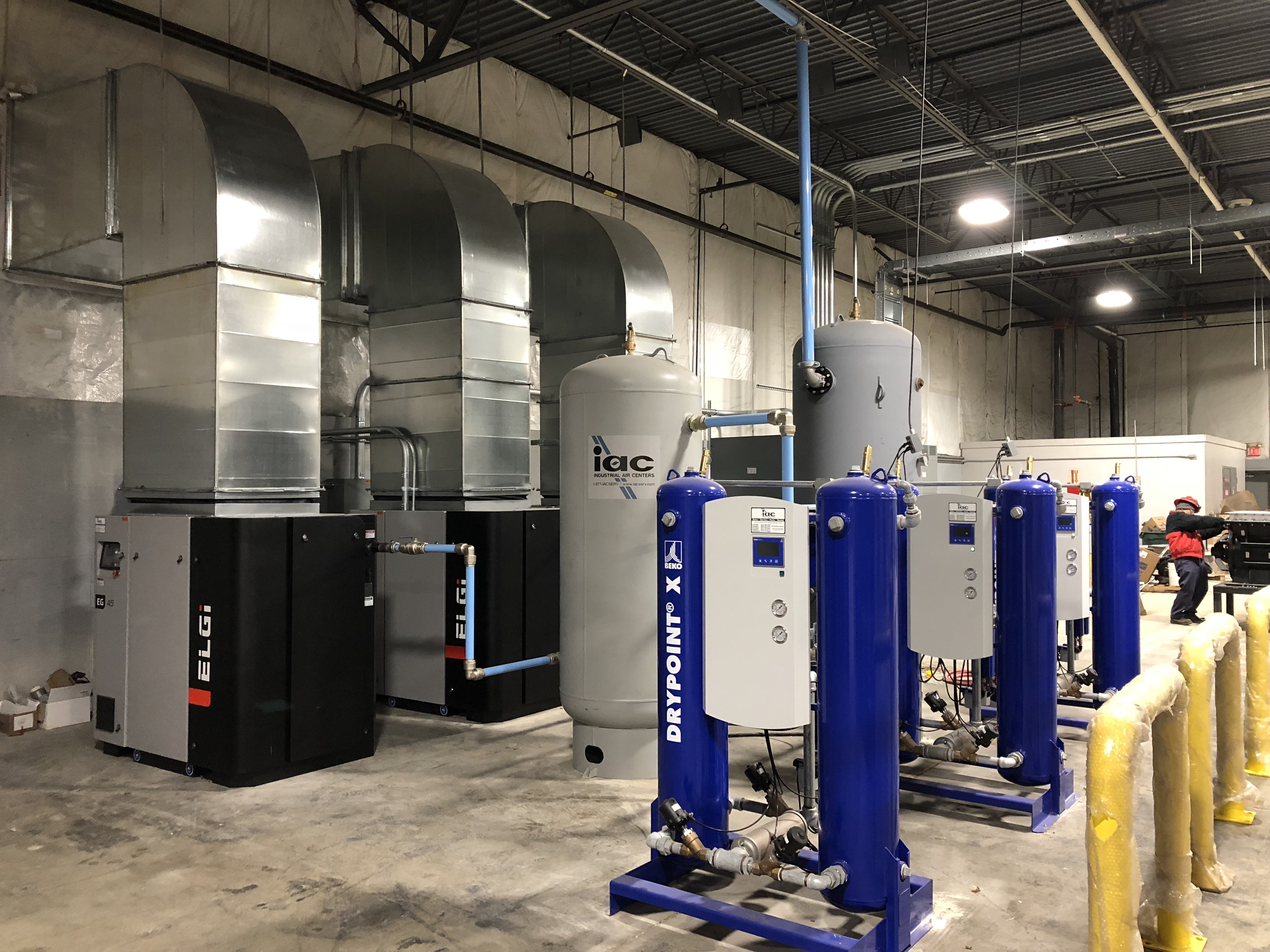Adaptive Air Insights - October 2025
Posted by Industrial Air Centers on 10/10/2025
Every month, Adaptive Air Insights brings you expert knowledge from the field with practical ways to improve reliability, boost efficiency, and make every cubic foot of compressed air go further.
Safety First: Don’t Ignore the Small Leaks
Compressed air leaks are more than just an energy drain. They are a silent hazard. A single 1/8" leak at 100 PSI can waste over 30-40 CFM, costing $1,200–$2,000 per year in lost electricity. But leaks also create unstable pressure zones across your system that affect tool performance, cause mechanical stress, and accelerate wear on valves, seals, and bearings. .
What to Look For
- Hissing or whistling noises near fittings, couplings, or hoses
- Inconsistent pressure readings between compressors and points of use
- Compressor short cycling or unexpected run times
Proactive Steps
- Schedule quarterly ultrasonic leak detection scans
- Document, tag, and prioritize leaks by estimated cost impact
- Re-evaluate fittings and piping in areas of high vibration or temperature swings
At IAC, we treat leak prevention as a safety and reliability issue, not just a maintenance task. Our teams use digital documentation tools to track leaks over time - helping plants not only fix current inefficiencies but also predict future risk zones.
Industry Insight: The Future of Compressed Air
The compressed air industry is in a transformation period. Between energy regulations, automation advances, and smarter system integration, the next few years will redefine what “efficient” truly means. To understand where we stand now, it helps to see how we got here:
October 9, 2024: DOE Final Rule Published
- DOE issues a Final Rule in the Federal Register (89 FR 81994) establishing new certification, labeling, and enforcement provisions for multiple categories of consumer and industrial equipment, including compressors.
December 23, 2024: DOE Final Rule Becomes Effective
- The October rule becomes effective, with manufacturers required to submit initial certification reports for affected equipment by May 7, 2025.
March - May 2025: DOE Rule Overturned via CRA
- After being passed by the House (March 5) and Senate (April 30), H.J.Res. 42 was signed into law by the President on May 9, 2025 (Public Law 119-8).
- This nullifies the October 2024 DOE rule, giving it no force or effect, and the DOE becomes legally obligated to remove those provisions from the Code of Federal Regulations.
September 9, 2025: DOE Issues Rescission Final Rule
- DOE publishes a Final Rule (90 FR 43371) formally rescinding and amending the October 2024 provisions.
- This action reverts certification, labeling, and enforcement requirements to the versions that existed prior to October 2024.
Why This Matters For You
- The regulatory landscape for equipment certification is in flux, which may affect how compressor manufacturers label, certify, and bring products to market.
- Buyers and specifiers should stay alert to evolving DOE guidance and enforcement updates to ensure compliance with acceptable certifications.
- This period of transition creates temporary uncertainty in procurement and may favor vendors who can adapt quickly to regulatory changes.
Smarter Plants, Smarter Air
Modern facilities are integrating compressed air systems into Plant Energy Management Systems (PEMS) and Building Management Systems (BMS) allowing remote monitoring, automated scheduling, and system-wide optimization.
At IAC, we’re leading this evolution by:
- Supporting SCADA/BMS integrations for real-time visibility
- Offering energy audits that align with ISO 50001 best practices
- Designing turnkey upgrades that deliver immediate ROI and compliance readiness
Why It Matters
As energy costs rise and sustainability targets tighten, these changes aren’t optional - they’re competitive advantages. Facilities that embrace monitoring, control, and efficiency now will set the benchmark for performance across the industrial landscape.
Save Energy, Save Money: Smarter Control Strategies
Energy is the most expensive part of your compressed air system as 70% or more of lifetime cost comes from electricity, not equipment. Yet most facilities still run compressors at fixed loads, higher than necessary pressures, or poorly sequenced setups that waste thousands in unneeded energy.
Common Hidden Inefficiencies
- Pressure Overcompensation: For every 2 PSI you raise system pressure, energy use increases by 1%. Many plants operate 10-15 PSI higher than needed simply to “cover” leaks or demand swings.
- Unbalanced Sequencing: Multiple compressors running simultaneously without coordination lead to idle running and excessive cycling.
- Inefficient Controls: Older electromechanical controls lack the precision to manage modern demand fluctuations.
Where the Savings Live
Modern systems integrate smart sequencing controllers, variable speed drives (VSDs), and real-time flow monitoring to match supply with demand minute by minute. The benefits are immediate:
- Eliminate unloaded running time
- Maintain pressure within tighter bands (±2 PSI)
- Automatically balance runtime across multiple units
- Capture detailed performance data for trend analysis
Your Energy Efficiency Roadmap
- Conduct a System Assessment: Review demand profile, leaks, and pressure drops
- Implement Smart Controls: Add sequencing and VSDs where applicable
- Optimize Air Treatment: Dryers, filters, and separators impact pressure loss
- Track Wnergy KPIs: kW/100 CFM is the industry benchmark for performance
Maintenance Matters: Predict, Don’t React
Reactive maintenance is costly. It leads to unplanned downtime, wasted energy, and stressed operators scrambling to find rental compressors at the worst possible time. The reality is: most compressor failures are predictable when you know what to look for.
Why Predictive Maintenance Outperforms Preventive
Traditional preventive maintenance focuses on set intervals, changing oil every 2,000 hours, and replacing filters every six months. But not every plant operates the same way, and environmental conditions like humidity, dust, and temperature can accelerate wear unevenly.
Predictive maintenance uses real-time data to adjust service based on actual equipment performance, not the calendar.
With connected sensors and digital tracking, you can monitor:
- Temperature trends in bearings and airends
- Amp draw and power factor changes
- Oil carryover or pressure differential in filters
- Moisture levels in dryers and separators
When thresholds drift outside normal operating ranges, maintenance can be scheduled before failure, eliminating costly downtime and secondary damage.
The IAC Advantage: Adaptable Service Agreements
Every facility is different. That’s why IAC’s service agreements are modular and adaptive designed around your production schedule, environment, and energy goals.
We don’t just “maintain compressors.” We:
- Analyze system loading patterns
- Review your utility data for waste and inefficiency
- Align maintenance intervals with your operational demand
The result? You extend component life, lower your cost per CFM, and maintain a reliable air supply that matches the pace of your operation.
Top Questions from October
What our customers have been asking and what you should know heading into fall.
Each month, we gather the most common questions from plant operators, maintenance managers, and engineers in the field. September’s conversations focused heavily on seasonal transitions, maintenance timing, and system optimization as plants prepare for cooler months.
Here’s what customers asked most and how IAC experts responded:
Why is my system showing more pressure drop than before?
As temperatures drop and humidity changes, the air entering your compressors becomes denser, which can alter flow dynamics across filters, dryers, and distribution lines. Moisture loads also increase as condensate collects in piping and filters after a humid summer.
Our Advice:
Start with the basics. Check filters and dryers for saturation, inspect for condensate buildup, and look for restrictions in your piping system. Pressure differential gauges are your friend and even a few PSI drop across filters can signal it’s time for replacement. Seasonal transition is the perfect time to flush your lines and clean or replace filters to restore stable system pressure.
Should I change oil or filters now that summer’s over?
Yes, fall is one of the best times to perform fluid and filtration maintenance. High summer temperatures accelerate oil oxidation and degrade viscosity faster, especially in rotary screw compressors. When oil loses its lubricating properties, bearings and airends take the hit.
Our Advice:
Conduct an oil analysis if you haven’t recently. Look for elevated particulates, moisture content, or metal presence. Replace intake, separator, and oil filters if differential pressures are trending upward. Doing this now prevents expensive repairs and ensures your system runs efficiently through winter.
What oil type should I use as ambient temperatures drop?
Not all compressor oils perform equally across temperature swings. As weather cools, oil viscosity increases, which can cause sluggish starts or poor lubrication until the system reaches full operating temperature.
Our Advice:
Review your compressor’s oil specs as most manufacturers offer temperature-specific or synthetic blends designed for stable viscosity in cooler climates. Synthetic oils often hold up better to wide temperature variation and reduce startup stress. Always match your oil grade to the lowest expected ambient temperature in your facility.
Can I retrofit my existing compressors with energy-saving or smart control options?
Absolutely. Many facilities mistakenly assume they need an entirely new system to gain modern control and efficiency features, but that’s rarely the case.
Our Advice:
Variable speed drives (VSDs), smart sequencers, and heat recovery systems can often be retrofitted into existing compressor packages. These upgrades help balance compressor load, minimize idle time, and reduce energy waste, often paying for themselves within the first year. IAC specializes in analyzing your system’s operating profile and identifying which retrofits deliver the best ROI.
Wrapping It Up: Adapting Forward
Every plant’s compressed air system tells a story, one written in pressure trends, energy usage, and uptime. The key is reading that story early enough to act on it. Whether it’s tightening maintenance routines, investing in smarter controls, or preparing for the next wave of efficiency standards, success comes from staying proactive, not reactive.
At IAC, we’re not just keeping up with the industry; we’re helping lead it. Our teams combine decades of field experience with forward-thinking technology to deliver one thing above all else: more compressed air with less energy.
As you move into the final quarter of the year, take time to evaluate your system’s performance, plan your maintenance strategy, and identify where efficiency gains are waiting to be captured. Small adjustments now can mean major savings, stronger uptime, and a safer operation later.
Ready to take the next step toward reliability and efficiency?
Schedule Your System Assessment →
Explore Preventive Maintenance Programs →
Shop for Equipment and Parts →
When your air system adapts, your entire operation performs better.
That’s Adaptive Ready Air.



